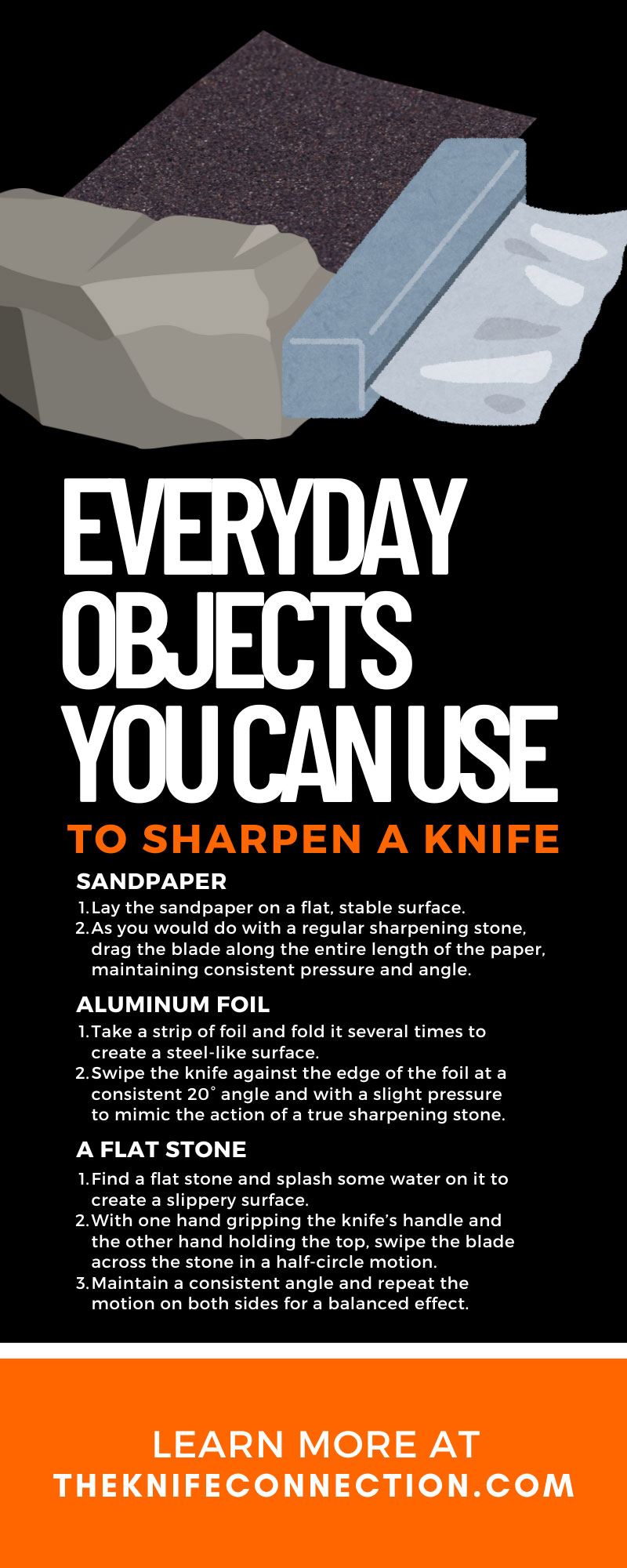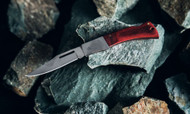Everyday Objects You Can Use To Sharpen a Knife
Apr 30 2024 - 11:23
A blade is a vital tool for anyone who carries one regularly. However, it must be sharp enough to cut through objects properly. Sharpening stones might not always be handy, so it’s good to know about other options that can efficiently sharpen a knife.
But while these methods can be useful in a pinch, they come with their own set of risks and might not offer the precision of professional tools. That’s why we’re here to give you a rundown of everyday items that can work to sharpen your knife and how to use them while also covering the basics of their potential pitfalls and why it might be time for you to invest in a quality sharpening stone.
Everyday Objects You Can Use for Sharpening
Sharpening a knife isn’t a process you can do by grinding the edge of your blade across anything you can find. You must choose an object that’ll sharpen it in a practical way. Here, we take a closer look at potential makeshift sharpeners that should be easy to find around your home or in the wild.
A Leather Belt
A surprising item you can use on your knife’s edge is an old leather belt. Leather, particularly the inner surface of strong, untreated leather, can help realign and polish the edge of a knife.
- With your leather belt taut, lay it on a flat surface.
- Draw the blade’s edge and spine along the entire length of the belt, maintaining a constant angle and applying light pressure.
- Repeat on the other side to ensure an even edge.
It’s important to note that leather is not an abrasive material, so it can’t actually sharpen your knife. However, it can help the blade maintain its edge between actual sharpening sessions, helping it last longer than usual.
The Bottom of a Coffee Mug
Who knew your favorite Monday morning pick-me-up could be instrumental in blade care? That rough ceramic surface at the bottom of your mug can give your blade a surprisingly sharp edge.
- Place the mug upside down on a sturdy surface.
- Hold the knife at a 20° angle against the ceramic.
- Apply light pressure and draw the blade across the bottom of the mug in an arching motion.
Be cautious; this method can quickly reduce the steel on your knife if you’re not careful and should only be used when absolutely necessary. This method is best for touching up a fairly sharp knife rather than re-edging a completely dull one.
Sandpaper
If you need something that can provide a bit more grit than a coffee mug, a sheet of sandpaper might be just what you’re looking for. The key here is to use high-grit paper rather than coarse paper, which would grind away too much steel.
- Lay the sandpaper on a flat, stable surface.
- As you would do with a regular sharpening stone, drag the blade along the entire length of the paper, maintaining consistent pressure and angle.
This method can be effective for minor touch-ups, but again, it’s not going to restore a heavily dulled knife. It’s more of a rapid-response, temporary solution.
Aluminum Foil
It’s time to look at aluminum foil in a whole new light. Layering the foil into a thicker surface and using it to sharpen a knife falls into the category of temporary measures, but it can sure be a useful one.
- Take a strip of foil and fold it several times to create a steel-like surface.
- Swipe the knife against the edge of the foil at a consistent 20° angle and with a slight pressure to mimic the action of a true sharpening stone.
This on-the-fly approach is better suited for knives that are only just beginning to show signs of dulling. It’s not the most precise or effective method, but it can work well in a bind.
A Flat Stone
Among the most effective DIY sharpening methods, this one is one of the best. Using a flat stone as a makeshift whetstone can genuinely restore a blade’s sharpness, as long as the stone has a fine enough grit.
- Find a flat stone and splash some water on it to create a slippery surface.
- With one hand gripping the knife’s handle and the other hand holding the top, swipe the blade across the stone in a half-circle motion.
- Maintain a consistent angle and repeat the motion on both sides for a balanced effect.
Unlike the other previously mentioned methods, this step will require more care and patience, especially if you’re dealing with a high-quality knife.
The Dangers of Using These Objects
While these everyday objects you can use to sharpen a knife are intriguing, they come with undeniable risks and limitations. While we’ve briefly mentioned some of these, we’ll go into greater detail on why you shouldn’t use these items unless you absolutely have to.
The Personal Injury Risks
Using a non-standard sharpener can lead to several potential issues. For one, these household objects can vary in abrasiveness due to age or material variations. This causes inconsistent pressure that can lead to you losing control of the knife. More often than not, this will increase the potential risk of injury. If you must use one of these items, be sure to take things slowly and remove any factors that could make the working conditions more dangerous.
The Inefficiency of Quick Fixes
Quick-fix methods like using the bottom of a mug or aluminum foil are just that—quick fixes. They won’t give you a long-lasting sharp edge but will prolong the inevitable trip to the sharpening stone. In fact, if used too often, they can even cause the blade to lose its temper, turning its hard steel edge completely soft.
Potential Damage to the Blade
Using makeshift sharpening techniques can also have long-term consequences for your knife. If you’re not careful, you may end up with chips or a blade that’s unevenly beveled. While some of these issues might be fixable with a real sharpening stone, using such tactics over time will wear down the blade and possibly render it useless. If your blade is ever beyond repair, be sure to check out our LT Wright knives for sale. They will serve as a fine replacement for your old knives.
Why You Should Invest in a Real Sharpening Stone
A real sharpening stone is a must-have for the true knife connoisseur or anyone interested in the lasting care of their blades. Here’s why it’s worth putting down the money for a quality sharpening stone.
Safety First
A sharpening stone is a predictable and consistent tool, and as such, it’s much safer to use than household objects that weren’t made with blade sharpening in mind. This will make general usage much easier and safer overall.
Better for Blade Longevity
Unlike most DIY solutions, a sharpening stone is specifically designed to gently remove steel from the blade to create a new edge. Quality stones are also designed to help maintain the temper of the steel, an important factor for a knife’s durability.
Customizable Options
Each blade is unique, and so are sharpening stones. Professional stones come in a variety of grits, allowing you to customize how you want to sharpen your blade. This will lead to improved results for all your knives.

